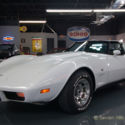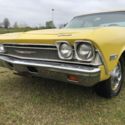4-speed, hardtop, awesome paint and chrome, runs and drives very well, enjoy now
| Make: | Chevrolet |
| Model: | Corvette |
| SubModel: | Roadster |
| Type: | Convertible |
| Year: | 1958 |
| Mileage: | 1,782 |
| VIN: | J58S107912 |
| Color: | Silver |
| Cylinders: | 8 |
| Fuel: | Gasoline |
| Transmission: | Manual |
| Interior color: | Gray |
| Vehicle Title: | Clear |
| Item location: | Macedonia, Ohio, United States |
1958 Chevrolet Corvette Additional Info:
Corvette enthusiasts all have their favorites, and most are quite particular about it. One isn’t merely a fan of the early solid axle Corvettes, there’s a year that speaks to you clearly, because GM engineers and stylists rewarded customers with new details and equipment year after year. Unlike today where cars change very little, back in the 1950s the differences were marked and easy to spot and today it’s those little differences that make the cars special. For many C1 Corvette aficionados, the 1958 models hold special appeal due to their many unique details and an extra helping of chrome, which practically defines cars of all kinds from the decade of glitz and glamour.
“New and improved” was more than just a slogan in 1958, particularly with the Corvette, which saw its most sweeping changes since the introduction of the V8 engine in 1955. Quad headlights made their debut, as they were finally legal in all 50 states, and it dramatically transformed the Corvette’s look. This lovely silver blue Corvette, complete with optional Silver side coves, perfectly captures the redesigned Corvette’s dual-purpose nature. Handsome and upscale, it is welcome almost anywhere, yet this car’s brutal rolling stock gives it a road race look that’s incredibly appealing. The restoration was completed perhaps 25 years ago, but it hasn’t been used very much so the finish and fiberglass bodywork remain in excellent condition throughout. It appears that these are this car’s original colors, and it’s easy to see why Silver Blue was the second most popular color that year, with 2006 cars (out of a miniscule production run of only 9168 Corvettes in 1958) being painted that way. They don’t track how many received the Silver side coves, but the fraction is surely smaller. At any rate, all of the 1958’s unique features are fully intact and restored, from the aforementioned headlights to the faux louvers on the hood to the chrome spears on the trunk. The paint has a wonderful soft gloss that’s completely appropriate to the vintage and the workmanship was quite good overall. Fit and finish are typical Corvette, better in some areas than others, with doors that close well and fit flush, but the trunk lid’s fit is off just a bit, which is probably how it came from the factory.
Chrome on the ’58 Corvettes followed the rest of the industry: more, more, more! In truth, it really dresses the car up and makes it look highly detailed and ornate, which is a fantastic contrast to the subtle paint. Most of the shiny bits on this car have been restored or replaced with exact reproductions, and it looks fantastic. The grille is one of the most recognizable details of the 1950s, showing up on custom cars for decades, and the slender bumperettes fore and aft make the car look well-proportioned and not at all heavy. Spears sweep back from the chrome headlight rings, perhaps mirroring those on the trunk lid, and the beautiful emblems on the nose and tail are beautifully rendered and in excellent condition with no cracking or spalling. Taillights faired into the rear fenders are beautifully rendered with clear lenses and more delicate chrome. There’s a bit of discoloration around the exhaust tips, which are flush with the rear bumpers, but that’s probably unavoidable on a car that’s been driven.
The blue-gray vinyl interior was restored at the same time using reproduction seat covers that are a good facsimile of the original materials and patterns. There’s almost no wear on any of the seating surfaces, indicative of a car that hasn’t been driven much since it was finished. The carpets are a lighter shade and it’s hard to determine whether they’re faded or intentionally a slightly different color, but it’s an attractive look that seems to fit the car’s ‘50s personality. The biggest demerit is the steering wheel, which is original and cracked, and while it appears that someone may have tried to restore it, that’s where some time and effort needs to be invested (and partially why this car is so affordable). On the other hand, the gauges are bold and bright, and they all work except the temperature gauge, which is likely a sending unit issue that we haven’t investigated yet. There’s a modern AM/FM/cassette radio in the dash, but the original AM radio is included with the car should you wish to take it back to original spec. Lights, wipers, turn signals, and the heater fan are all working properly, too. There are a few squeaks and rattles in the cockpit, which is fairly common in early ‘Vettes, and an ambitious hobbyist could probably track them down by spending a few hours on the task. There is no convertible top and it doesn’t appear that this car ever had one, which is unusual but not unprecedented in the world of Corvettes, and the matching removable hardtop has been restored to match the rest of the car—check out the ornate and beautifully finished headliner! The trunk is likewise spartan but includes a full-sized spare tire assembly and excellent inner panels with no signs of trouble anywhere.
Chevrolet wasn’t doing matching numbers in 1958, and we’re fairly certain this isn’t the original 283 cubic inch V8 engine, but we can say that it looks right and runs superbly. Thanks to a full rebuild a few years ago and a built-in electric fuel pump, it starts quickly and easily, even when it’s cold, an idles remarkably smoothly for a performance Corvette engine. On the road, it’s got a broad torque curve and enough power to spin the tires if you’re too aggressive in first or second gear, and there’s a wonderful V8 soundtrack from the dual exhaust out back. Up top there’s a Carter AFB 4-barrel carburetor and factory intake manifold, as well as a familiar louvered air cleaner, a Corvette look that endured for years. Finned valve covers are another nice dress-up piece, and it’s all bathed in a coat of Chevy Orange engine enamel that brightens up the engine bay. All the original chrome ignition shielding is still in place and correct hoses and clamps were used on the cooling system. You’ll note the heater core is bypassed to keep heat out of the already toasty footwells, and there’s an oversized flex fan on the radiator plus an electric pusher fan up front. A modern alternator takes the place of the original generator, and it has no trouble keeping up with the big electric fan and other accessories. There’s plenty of oil pressure, it never threatens to get grumpy or hot, and goes about its business with plenty of power but doesn’t make a big show of it. If you want a Corvette to drive, this is an excellent choice.
Remarkably, only about a third of 1958 Corvettes were equipped with the optional $215.20 4-speed manual gearbox found in this car. The well-chosen ratios work perfectly with the engine’s power band, snapping through the gears and hitting the exact spot on the tach where the engine will land, so there’s a seamless flow of power not matter how hard you’re running. I suspect part of that is due to what we believe to be optional 3.70 gears out back, which give this car very punchy acceleration around town, regardless of the gear chosen. The engine’s flexible torque curve will move the car in fourth from anything but a dead stop, and it seems to pull without any flat spots or hesitation all the way through the rev range. The undercarriage is in excellent condition, if not detailed for show, with good floors (there’s no rust, obviously, because it’s fiberglass) and a frame that is in great shape with no evidence of rust or accidents. If you like to drive, this car will always be entertaining. The suspension and manual drum brakes are typical early Corvette, good enough for driving around town, but you’ll quickly understand just how brave those early racers really were. And speaking of racing, we love the industrial-strength race look of the simple painted wheels and standard hubcaps with beefy 215-15 Michelin blackwalls, which is very much how cars looked at the track in the late 1950s. If that’s not you, that’s OK—reproduction hubcaps are available and the age of the Michelins suggest a tire change would be a good idea anyway.
This is not a perfect car, and that’s why it’s priced the way it is. On the other hand, the cosmetics are excellent, the interior is inviting, and the engine is strong. If you want an early C1 “solid axle” Corvette that’s ideal for driving and casual shows, you’ll scarcely find any better than this. Call today!












